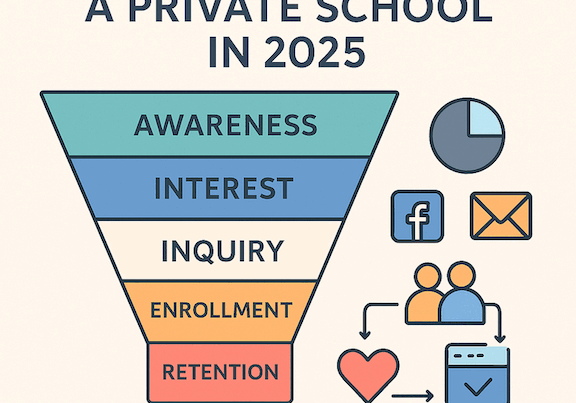
If you’re wondering how to best represent your private school while boosting the effectiveness of your marketing, you’ll need to break down exactly what makes a school website compelling and lucrative.
Outside of being set up properly on a content management system as an intuitive and beautiful website, the best school websites depend on three basic rules.
Read on to learn more about these rules.
Rule 1: Keep It Fresh and Relevant
The first rule of creating an exceptional school website design is to think of it as a constant work-in-progress. Websites are not static pages on the internet that can be set up and soon forgotten. School websites require dynamic updating in every capacity to properly reflect the school as it matures and evolves over time.
Be certain that the school website is up to date with modern technological capabilities while maintaining the most accurate information for prospective and current families.
Updating Practical Information
Not long ago, the preferred way of communication was in-person or through phone calls. Now, parents and students will visit a school’s website FIRST for information before they resort to picking up the phone or communicating with a friend or family member for information. As a result, leaving a school website static for too long can result in lost enrollment and confused current parents and students.
Poor website accessibility and inaccurate content cause frustration and confusion and may result in lost enrollment. Updating all practical information on the school’s website will help parents and students access important knowledge quickly, therefore keeping them engaged.
For example, you should update academic calendars as frequently as possible or students will not have access to important enrollment and attendance information. If the school calendar changes, you should communicate these changes promptly online.
Further, not updating organizations, clubs, and programs can cause difficulties with parents and students finding channels for community involvement. Students might become excited about a group that no longer exists, only to be disappointed. Parents might attempt to volunteer for a committee, only to realize they’ve been contacting the wrong person.
Regarding communication, not keeping updated bios and contact information for faculty and staff makes it challenging for parents and students to connect with them. Families will not easily access the school’s professionals, whether they are interested in certain programs or have questions and concerns.
Overall, keeping the website accurate will keep students and parents interested and involved with the school.
Highlight Important Changes
To tell the school’s updated story, refresh the website’s content regularly and upload current information every time something changes. Families, both new and current, need messaging and content that resonates with them to keep them engaged. In other words, keeping the school’s website fresh, accurate, and helpful will improve marketing greatly.
Basic essential information, such as academic calendars and enrollment resources, should be updated and easy to find. More fleeting and time-sensitive information, however, should not be neglected. Parents and students do not only need basic information but frequent updates on changes such as new policies, changes to the school calendar, and events happening on campus.
In order to maintain the best school website, emphasizing current events on the most prominent page will help keep families informed. The current community will be grateful for such effective communication, and new families will be impressed with the school’s management.
Furthermore, communicate more personal announcements that help the community connect with the institution. Instead of keeping every note objective and formal, keep the school’s values in mind and add the human touch. In response, families will feel pride in their institution.
Keep The Design Modern
Keeping a school website fresh means updating the design to reflect current trends in design. In one sense, being trendy may be in poor taste because trends are fleeting and frequent changes can ruin your school’s brand. On the other hand, a smart refresh that maintains the essence of your brand while tending to modern expectations will keep your school’s website relevant.
All branding, including messaging, should reflect your institution’s personality, values, and speak to the target audience effectively. If your website seems outdated, interested visitors will most likely move on.
Educational website design should be functional regarding technological updates and be accessible for all visitors. For instance, there are frequent updates to expectations regarding website accessibility, such as including alt text for pictures. Further, there are ever-evolving ways to improve website functionality and usability, such as making it reactive to different devices.
Rule 2: Attract New Families
The point of a school website is to be an extension of the school and its community, so leaving it outdated creates a divide that’s hard to cross. If it takes longer than a minute to gain an impression of the school and understand its mission and values, then that visitor is likely disinterested going forward.
In order to attract new families, you’ll need to improve your image and tailor your website towards their needs. Then, you’ll need to implement a strong SEO strategy to make the website a top search result for specific keywords.
When prospective families are looking for a school, they’re looking for programs and organizations within their interests. Consequently, parents and students who see those programs on a school’s website will be impressed and more likely to enroll.
For example, the school may not concentrate on one specific academic area, such as arts or entrepreneurship, yet the school thrives in such areas. It’s important to highlight these because students and parents may be searching keywords related to these concentrations, so you want to be sure that your school is at the top of such search results.
Once the school’s image has been effectively niched towards certain areas of interest, and content on those programs has been uploaded, the website should be analyzed for SEO. Building pages and content around making the school searchable online will improve marketing to new families.
For example, if a student searches for “best schools for high school biology,” and the school has SEO content surrounding high school biology, then it’s more likely for that student to click on the school’s website and consider enrollment.
While crafting your content, remember that students are often the first researchers for schools. If they become excited about a school, then they will share with their parents who then make the decision. Building your content around getting prospective students intrigued and excited will improve enrollment.
Rule 3: Connect With The Existing Community
A school website is meant for both current and prospective families to benefit from updated information and easy access to all channels of communication. While you’ve boosted your marketing with effective SEO strategy for new families, you still need to provide a welcoming feel and help your current community flourish.
To achieve this thriving community, you will need to take advantage of different mediums and platforms. Communities can often thrive best when facilitated through social media accounts, for example. By including social media feed widgets on your site, visitors can access the school’s social media and subsections of the community like clubs and programs.
Further, you can update the website with video content highlighting achievements and events held by different programs and groups. Doing so will help the whole community stay informed about what other community members are doing and could encourage more participation.
In addition, you can include an events page that keeps an updated calendar about community efforts and activities. Consequently, community members can find opportunities to get involved with other community members.
When it comes to the community interacting with the school, it’s important to also include faculty and administration. Parents and students should not only connect with each other, but with teachers, staff, and leaders. As a result, the institution will be more transparent and welcoming.
For example, teachers should not only be listed by name, but have detailed bios, pictures, and even short video interviews that help website visitors get to know them. Content such as articles and videos about current efforts and achievements from staff and leaders can help the community stay informed and get to know the people who run the institution better.
A successful school website facilitates a thriving community.
Create the Best School Websites
The best school websites will be fresh, relevant, and inviting to both new families and existing community members. The design should be inviting and functional while the content is accurate, interesting, and searchable. It never hurts to combine this website with a robust social media strategy as well to bolster community outreach and interactions.
If you’re ready to improve your school marketing strategy now, contact VujaDay for marketing services in web design, SEO, social media, and content marketing.



